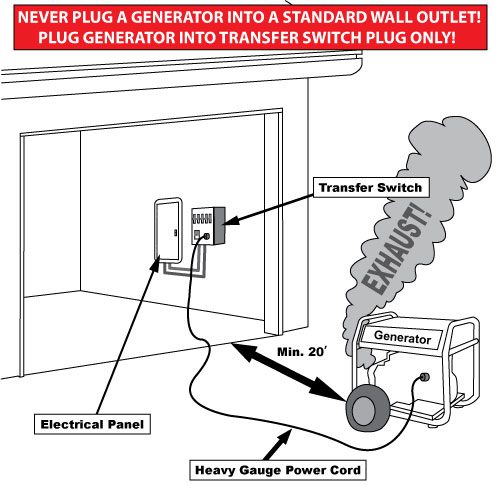Generator Safety
Generators can help keep the lights on and run appliances when the power is out, but improper use of a generator can be a danger to you, your neighbors, and PUD line crews.
Improper connection of a generator is called “backfeeding”. Backfeeding is when power from a generator travels through the electrical panel out to the transformer, which then is converted into thousands of volts and distributed onto the neighborhood’s utility lines. Any generator not used to directly feed a specific appliance must be routed through a professionally installed transfer switch at the homes electrical panel.
Remember: A line crew responding to an outage does not know a line is being backfed and contact with the energized line can be fatal! Lines damaged by a tree that are on the ground can also carry lethal amounts of energy. Always stay at least 50 feet from any down lines and contact the PUD right away!
It’s important to understand the two main types of generators and their applications.
There are two kinds of generators: portable and permanent. Portable generators are intended to provide power to an extension cord which is then plugged directly into an appliance or piece of equipment. Permanent generators are wired directly into the electrical system of your home.
Portable Generators
Portable generators can’t power your entire home, as most typically generate about 1,500 to 8,000 watts. Plugging the generator into an electrical outlet inside (or outside) your home or running it through the electrical panel without a professionally installed cut-off switch is extremely dangerous and will put you and our utility crews in life-threatening danger. Instead, you should plug an extension cord directly into an appliance. Use a heavy-duty extension cord rated for the size of your generator.
It is very important to take care when choosing a place for the generator. You don’t want deadly carbon monoxide to creep in. The exhaust from a generator, like from any combustion engine, is dangerous.
A small generator puts out a hundred times more carbon monoxide than car exhaust.
If you operate a portable generator, make sure to install carbon monoxide detectors in the main living and sleeping areas of your home and be sure to locate portable generators at least 20 feet away from your home and never near a door, window, or vent. Find a dry location and if need be, you can use a portable canopy to shield it from the rain, but do not place in open garages or under porch roofs adjacent to the home.
Permanent Generators
Permanent generators are wired directly into your home’s electrical system. They are also referred to as stand-by generators.
Installing these types of generators require the help of a licensed electrician. The installation must be in compliance with the National Electric Code along with local, county and state requirements.
A permanent generator must include a manual transfer switch. The transfer switch allows power to be fed from only one source at a time, which prevents the generator from feeding back into utility lines and surprising a utility worker.
Permanent generators are seldom large enough to power an entire home. A transfer switch distributes power to the circuits a homeowner has selected during the installation process. This can be a microwave, refrigerator, wall outlets in a living room, or a blower for a propane fireplace, etc.